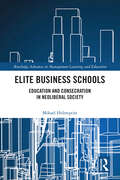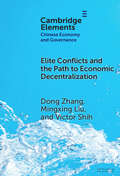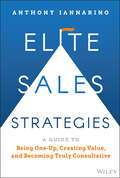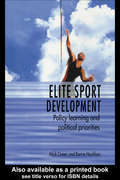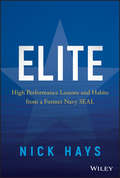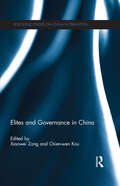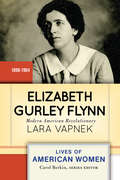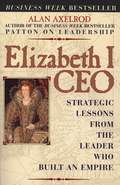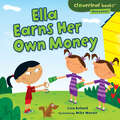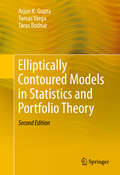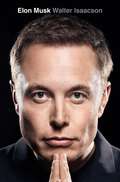- Table View
- List View
Eliot Spitzer: Pushing Wall Street to Reform
by Jonathan Schlefer Rawi Abdelal Rafael Di TellaNew York State Attorney General Eliot Spitzer faced a decision about how to stop wrongdoing committed by major Wall Street firms during the Internet boom. The equities analysts of Merrill Lynch and other Wall Street firms were charged with objectively advising retail investors whether to buy or sell publicly traded stock. The analysts had rated some stock a strong buy, while at the same time disparaging it in Internet emails as "a piece of junk" or a "powder keg." Spitzer concluded that the analysts sometimes issued such buy ratings on stock of companies because of a conflict of interest: the Wall Street firms the analysts worked for were making handsome fees for underwriting the companies' stock offerings and providing other services. The usual procedure when an enforcement agency such as the Federal Securities and Exchange Commission (SEC) discovered such a situation would be to complete its investigation and negotiate a resolution privately with the financial firm. If it could not resolve the matter, the agency would formally file suit against the firm in court. This option was open to Spitzer, but the 1921 New York statue gave him an alternative. Even before filing suit in court--and while continuing to investigate the firm further--he could broadcast his findings to warn the public and brand the firm with wrongdoing. This case investigates the decision Spitzer made, and its long-term implications for U.S. financial regulation and financial industries.
Elite Business Schools: Education and Consecration in Neoliberal Society (Routledge Advances in Management Learning and Education)
by Mikael HolmqvistSocial scientists are paying increasing attention to the business and financial elites: There’s a great need to understand who these elites are, what they do, and what makes them tick, as individuals but also as a class. By examining elite business schools, the institutions that train and prepare people to assume important leadership and decision-making positions in business, finance and related sectors, we may also learn how the economic elites are made. A key argument in this book is that elite schools are known to create powerful groups in society, offering them the intellectual and analytical means to act as leaders, but, most importantly, the social, moral and aesthetic skills that are deemed necessary to exercise power; in all essential respects elite schools consecrate people. By dominating much of higher education today, and by doing so in a way that creates and reproduces a market-based organization and control of society, elite business schools represent certain interests and ideologies that affect the lives of most people. In understanding how the modern economy is run, elite business schools, therefore, represent critical study objects. This book, based on an in-depth study of the Stockholm School of Economics (SSE), offers a sociological analysis of the world of elite business schools. Specifically, this book examines the consecration of SSE’s students from a number of perspectives and in a number of situations, focusing on student union activities, school culture, faculty behavior, teaching, courses and alumni events, noting the symbolic importance of economics and particularly the school’s unique relation among the world’s business schools to the Nobel Prize. The book addresses the topics with regards to the sociology of elites, management education and organizational studies and will be of interest to researchers, academics, and students also interested in business history, higher education studies, and sociology of education.
Elite China
by Pierre Xiao LuA ground-breaking exploration of the Chinese elite's consumption of luxury products and their attitudes toward luxury goods. Elite China identifies the Chinese luxury product consumers and the characteristics of their luxury consumption, explains the implications for luxury firms and marketers and most importantly, spells out strategies for international luxury brands and Chinese luxury brands to succeed in Chinese market.
Elite Conflicts and the Path to Economic Decentralization (Elements in Chinese Economy and Governance)
by Dong Zhang Mingxing Liu Victor ShihWhy would a politically centralized state embark on the path of economic decentralization? This Element delves into the political origin of the puzzling economic decentralization in mainland China. The authors contend that the intra-elite conflicts between the authoritarian ruler and the ruling elites within the state prompted the ruler to pursue decentralization as a strategy to curb the influence wielded by the ruling elites. By examining the composition of the Chinese Communist Party's Central Committee, they find that the Cultural Revolution, fueled by elite conflicts, shifted the elite selectorate's composition from favoring central agencies to favoring local interests. Subsequent low turnover reinforced this shift, aligning elite incentives with decentralization policies and committing the Chinese leadership to a decentralized path in the 1980s. Additionally, Taiwan's economic liberalization under the Kuomintang's authoritarian rule provides further evidence of the link between ruling party elite composition and economic policy orientation.
Elite Sales Strategies: A Guide to Being One-Up, Creating Value, and Becoming Truly Consultative
by Anthony IannarinoAccelerate your sales career with this how-to book from an expert in sales In Elite Sales Strategies, expert sales leader Anthony Iannarino offers his philosophy about becoming a commercial success. This guidebook provides unique insights into how to approach every sale by serving your clients from a position of authority and expertise. As Iannarino himself notes, this technique speaks to an ethical obligation towards your client, combining ethics and tactics to help place you in a position where your strengths can be fully utilized. This guidebook suggests putting yourself in a “one-up” position, where you, as the salesperson, come to a client in a position of authority and strength, where you yourself are qualified to offer nuanced and helpful advice to companies that have put themselves in a “one-down” position, whether that be by bad decision-making, poor understanding of the marketplace, or bad luck. At its heart, this book suggests you find the advantages that you can provide that will, in turn, help your client become “one-up” themselves in their own field and ensure they achieve the better results they need. In addition, Elite Sales Strategies provides readers with: A step-by-step approach for how to become “one-up” yourself and what you provide to your clients A healthy analysis of what makes a person or a company “one-down” and tips on how to course correct Strategies, tactics, and talk tracks that will provide you with what you need to become “one-up” Terminology and vocabulary so that you can approach your client with tact and decorum while still addressing the weaknesses of their system As a successful international speaker, author, and sales leader, Anthony Iannarino brings a unique set of skills to bear in this book. Iannarino's tried-and-true methodology is an ideal resource for sales professionals in all fields, as well as for executives and managers looking to improve their sales success and position within the business world.
Elite Sport Development: Policy Learning and Political Priorities
by Barrie Houlihan Mick GreenElite Sport Development addresses important sport policy questions and explores the emergence, development and current status of elite sport development policy with detailed examination of Australia, Canada and the UK. The sports compared are swimming, track and field athletics, and sailing. The book looks at the problems faced in establishing an elite sport development infrastructure covering facilities, coaching, sports science and competition. Likewise, full-time athletes are considered and the tensions that a pre-occupation with elite achievement generates within the sports is also examined. Includes: * why governments invest heavily in elite sport* the relationship between Government and NGB's* the impact of elite investment on 'sport for all' * the selection of individual sports for priority funding. This detailed text will be of interest to students, researchers and professionals working in sports development and policy.
Elite Youth Sport Policy and Management: A comparative analysis (Routledge Research in Sport Business and Management)
by Barrie Houlihan Milena M. Parent Elsa KristiansenElite youth sport competitions have increased significantly in number in recent years, with the Youth Olympic Games representing the high point of this phenomenon. This book examines the global context within which elite youth sport has emerged and continues to grow. It explores elite youth sport policy across fifteen countries, in Europe, the Americas, Africa and Asia, addressing the questions of how youth talent development is organised and why elite youth sport has become so popular. Taking a comparative global perspective, the book analyses the growth in more systematic approaches to young athlete development and the increasing emphasis on early talent identification. It discusses the attitude of stakeholders (such as NGBs, governments and sponsors) towards elite youth sport, while also considering how young elite athletes’ interests are protected and how the growth in elite youth sport affects a sport’s development strategy. Written by a team of internationally renowned researchers, Elite Youth Sport Policy and Management: A comparative analysis is fascinating reading for all students, scholars, managers, policy-makers and coaches with an interest in youth sport, elite sport development, talent identification and sports policy.
Elite: High Performance Lessons and Habits from a Former Navy SEAL
by Nick HaysProven tools to take your team and yourself to the next level Elite: High Performance Lessons and Habits from a Former Navy SEAL is a practical, no-nonsense guide to elevate your leadership skills and drive your team to their maximum potential. Before you can push your team to the max, you must push yourself—elite teams require elite leaders. This invaluable guide supplies the tools you need to develop effective strategies to motivate, adapt, and overcome. Author Nick Hays combines military training with Harvard education to present a comprehensive program that will unlock the potential in yourself and your team. The business environment has changed dramatically over the last several decades. Volatile market conditions, disruptive innovation, and digital transformations across entire sectors have rendered traditional business methods obsolete. To thrive, businesses must be adaptable, agile, and lean. Policies and procedures may change, but strong leadership and shared goals ensure a source of strength and continuity. Providing real-world methods and effective strategies, this essential resource will allow you to: Embrace the Warrior Mindset to always be proactive, never a victim Develop the trust of your team through strength and shared experience Devise durable and sustainable business strategies and contingency plans that adapt to fluid situations Promote a culture of innovation and authenticity to deliver a solid foundation for your team Elite: High Performance Lessons and Habits from a Former Navy SEAL is a must-read guide for everyone from aspiring entrepreneurs to established business leaders. No matter the stage of your business—development, exploitation, or disruption—Elite will change your approach to business and unlock the warrior within.
Elites and Governance in China: Governance And Elites In China (Routledge Studies on China in Transition)
by Xiaowei Zang Chien-Wen KouThis book reveals the complex relationship between elite perceptions and behaviour, and governance, in China. It moves away from existing scholarship by focusing on functionaries, grass-roots elites, leading intellectuals, and opinion-makers in China and by looking beyond the top leadership, makes a significant contribution to our understanding of shared governance and broadened political participation in China. The chapters in this collection explore the elites’ role as opinion-makers, technical experts, producers of knowledge, and executives or managers, and pose a number of questions, the answers to which are crucial to understanding future political and economic development in China. What are elite perceptions of governance, inequality and justice; what do the elites mean by good governance; what is the influence of non-Chinese Communist Party elites in policy-making and implementation in China; how have they exerted their influence in the PRC and influenced its direction of future development; and what have grass-roots elites contributed to governance in local communities? Providing a keen insight into the role elites have played in governing China since 1978, this book is a pioneering effort to bring together elite studies and governance studies. As such, it will be highly relevant for policy-makers within international organizations, governments, and NGOs outside China as well as appealing to scholars and students interested in Chinese politics and governance.
Elizabeth Best (A)
by C. Wickham Skinner Ardis BurstNew political appointee with years of volunteer experience takes over highly responsible job in state government and is met with bureaucratic resistance.
Elizabeth Best (B)
by C. Wickham Skinner Ardis BurstDescribes what a new political appointee with years of volunteer experience did in office.
Elizabeth Best (C)
by C. Wickham Skinner Ardis BurstDiscusses a problem that confronted the appointee later--how to get a large, complex job accomplished without evident resources.
Elizabeth Best (D)
by C. Wickham Skinner Ardis BurstDescribes how and what she did to accomplish the job.
Elizabeth I, CEO: Strategic Lessons from the Leader Who Built an Empire
by Alan AxelrodA Business Week bestseller-- now in paperback. Unlike other leadership books using historical figures (and mostly men) as models for business people, this highlights a famous woman leader. Hers was a surprising time for a woman to emerge as such a strong leader-- that her time was as troubled as ours is now an apt comparison. Here are business and management lessons for today's corporate leaders based on Elizabeth's leadership. The life of Elizabeth has much to say to those beginning their climb up the corporate ladder as well as to those who, having attained the top rung, do not want to slip from it. This title, like Axlerod's Patton on Leadership, will appeal to business book readers as well as history buffs. The hardcover edition of Elizabeth I, CEO has sold 55,000 copies.
Elizabeth Parker (A)
by Tiziana Casciaro C. Wickham Skinner David KrackhardtA new political appointee with years of volunteer experience takes over a highly responsible job in the state government and is met with bureaucratic inertia. Describes a successful strategy to overcome organizational resistance to change.
Elizabeth Parker (B)
by Tiziana Casciaro C. Wickham Skinner David KrackhardtSupplements the (A) case.
Elizabeth Parker (C)
by Tiziana Casciaro C. Wickham Skinner David KrackhardtSupplements the (A) case.
Elkay Plumbing Products Division
by Robert S. KaplanThe vice president of sales learns that the most profitable 1% of the division's customers generate 100% of profits, and that two of the division's largest customers lose 50% of profits. The division has just finished a project to install a time-driven activity-based cost system that traces costs directly to the processes used to produce, sell and deliver a wide variety of stainless steel sinks to a diverse customer base. Given the division's high variety of products and customers (which includes wholesalers, retailers, contractors, and distributors), the VP of sales wanted a much more accurate cost system so that he could conduct difficult but fact-based negotiations with customers. The case describes the design and implementation of the new cost and profit measurement system. It documents acceptance and decisions made by managers after seeing the enormous dispersion of profits among their products and customers.
Ella Earns Her Own Money (Cloverleaf Books (tm) -- Money Basics Ser.)
by Lisa Bullard Mike MoranHow should we handle our money? Ella really wants a soccer ball. But she doesn't have enough money to buy one. So she decides to earn her own money. Ella cleans the car for her mom, gives the neighbor's dog a bath, and sells bracelets to her friends to earn cash. Will she have enough money to buy the ball in the end? Read this book to find out!These simple, engaging stories present basic financial literacy concepts, such as saving, spending, borrowing, and comparison shopping to build a foundation for a lifetime of money smarts. Free downloadable series teaching guide available.
Elliott Wave Principle: Key to Market Behavior
by Alfred John Frost Robert Rougelot Prechter Jr.Describes a type of technical analysis used by some investors.
Elliptically Contoured Models in Statistics and Portfolio Theory
by Arjun K. Gupta Tamas Varga Taras BodnarElliptically Contoured Models in Statistics and Portfolio Theory fully revises the first detailed introduction to the theory of matrix variate elliptically contoured distributions. There are two additional chapters, and all the original chapters of this classic text have been updated. Resources in this book will be valuable for researchers, practitioners, and graduate students in statistics and related fields of finance and engineering. Those interested in multivariate statistical analysis and its application to portfolio theory will find this text immediately useful. In multivariate statistical analysis, elliptical distributions have recently provided an alternative to the normal model. Elliptical distributions have also increased their popularity in finance because of the ability to model heavy tails usually observed in real data. Most of the work, however, is spread out in journals throughout the world and is not easily accessible to the investigators. A noteworthy function of this book is the collection of the most important results on the theory of matrix variate elliptically contoured distributions that were previously only available in the journal-based literature. The content is organized in a unified manner that can serve an a valuable introduction to the subject.
Elmer Wheeler’s Tested Public Speaking [Second Edition]
by Elmer WheelerOriginally published in 1947, this is the Second Edition of "Elmer Wheeler's Tested Public Speaking" (1939). Brought up to date, it incorporates revised material based on Wheeler's further vast experience acquired in the course of giving 2,798 additional speeches since the publication of the first edition in 1939. It also includes his talk, "Take an Hour to Say No," which at the time of this 1947 publication had been reprinted over a record 7 million times."As usual, Elmer Wheeler has based this book not on fancy, academic rules, but rather on his own practical experience as an outstanding speaker in his own right."
Elon Musk
by Walter IsaacsonDo autor de Steve Jobs e outras biografias de sucesso, chega-nos a história surpreendentemente íntima de um dos inovadores mais controversos e fascinantes da atualidade - um visionário avesso a regras que levou o mundo para a era dos carros elétricos, da exploração espacial de iniciativa privada e da inteligência artificial. Ah, e comprou o Twitter. Entrega a partir de 12 de Setembro de 2023.Durante a sua infância, na África do Sul, Elon Musk foi vítima de bullying. Um dia, foi empurrado de umas escadas de cimento abaixo e pontapeado no rosto até este ficar uma massa ensanguentada e inchada. Ficou internado durante uma semana. Mas as mazelas físicas eram insignificantes quando comparadas com as feridas emocionais infligidas pelo seu pai, um carismático e engenhoso fantasista que agia por conta própria. Quando Elon teve alta do hospital, o pai repreendeu-o. «Tive de ficar de pé uma hora a ouvi-lo gritar comigo, a chamar-me idiota e a dizer-me que era um inútil», recorda. O impacto do pai na sua psique permaneceria. Transformou-se num homem-criança duro, apesar de vulnerável, com uma tolerância extraordinariamente alta ao risco, sedento de drama e com um sentido épico de missão e uma obstinação maníaca, tão insensível quanto, por vezes, destrutiva. No início de 2022 ? depois de um ano marcado pelo lançamento e colocação em órbita de 31 foguetes da SpaceX, pela marca de um milhão de carros vendidos pela Tesla e de se tornar o homem mais rico do mundo ?, Musk falou com pesar sobre a sua compulsão para criar dramas. «Preciso de mudar de mentalidade, sair do modo de crise, que é como tenho funcionado nos últimos catorze anos, pelo menos, se não a maior parte da minha vida», disse. Foi um comentário melancólico, não uma resolução de Ano Novo. Ao mesmo tempo que se comprometia a mudar, comprava, em segredo, ações do Twitter, o maior recreio do mundo. Ao longo dos anos, sempre que se encontrava num lugar mais sombrio, voltava a ser aquela criança agredida no recreio. Agora, tinha a oportunidade de ser o dono do recreio. CRÍTICAS A STEVE JOBS, DE WALTER ISAACSON "Fascinante." - The New York Times "Hipnotizante" - LA Times "Vibrante." - Kirkus Reviews "Um retrato vasto e complexo - mas incrivelmente consistente - do homem que criou a Apple." - The Verge "Uma narrativa franca e cativante" - Publishers Weekly

